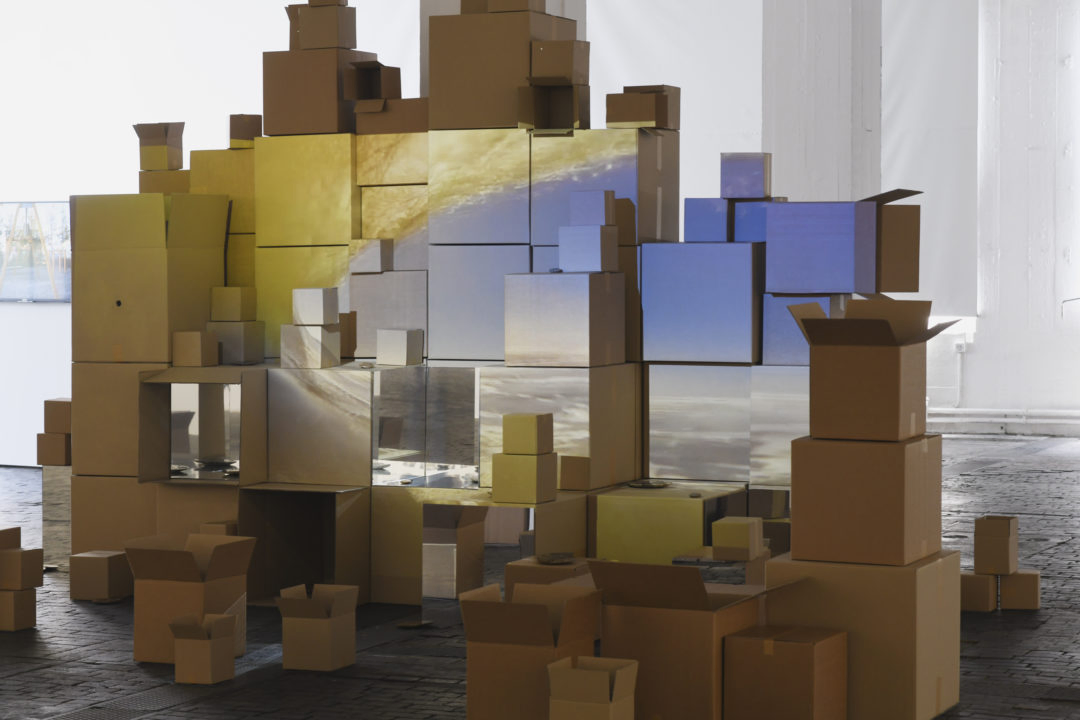What is conceptual art?
In conceptual art, the concept or idea behind a work is prioritized over aesthetics, materials, and craftsmanship. Conceptual art asks questions about the nature of art, art making, and the role of the artist, as well as broader questions about life. Much of conceptual art relies on viewer participation/perception and can be experienced by turns as humorous, serious, anti-authoritarian, overly intellectual, or just plain nonsense. You decide!
About Hreinn Fridfrinnsson and Hulkuklettur

From an article in Meer magazine:
The artist frequently works with the most simple everyday materials, altering them with precise minimal interventions, such as in his iconic work Sanctuary (1992–2014). The work consists of a cardboard box installed as an object on the wall at eye-level. Its top flaps are slightly opened to reveal an intense green colour shimmering on the inside of the cross-shaped object, suggesting an unfathomable, seemingly sacred space. In this slightly altered readymade, Friðfinnsson unfolds the conceptual and poetic potential of seemingly banal things that already exist. His lyrical conceptualism is close to the work of Marcel Duchamp as well as Arte Povera and Land Art. Characteristic of his work— which focuses on the most ephemeral, fleeting qualities of the world around him—is, however, a subtle sense of humour and the acknowledgement of a supernatural dimension. Narrative as well as a specific perception of landscape are deeply ingrained across his body of work. Landscape is conceived of as the result of a symbiosis of nature and psyche, rooted in the memories and sagas of his native Iceland.
In his new installation Hulduklettur (“black” or “concealing rock”—from the Icelandic huldur, meaning “dark” or “concealed,” and klettur, meaning “rock”) the artist presents a rugged landscape of cardboard boxes, amongst which can be found a variety of artefacts like ammonites, crystals, an anatomical model of an ear, images of a Nautilus and galaxies. Together, they form a complex picture of natural phenomena, the unifying element being the Fibonacci spiral. The spiral, which is considered to be the epitome of Fibonacci’s mathematical system, is understood as a kind of growth pattern and fundamental principle of nature. This symbiotic relationship between mathematics, philosophy, and aesthetics is executed as well in the work Principle and Temptation (1991), whose individual squares are proportioned according to the golden section, a calculation likewise derived from the Fibonacci sequence.
From an article written about “For the Time Being,” an exhibition at the Museum of Art and Design Miami Dade College (MOAD): https://moadmdc.org
A kind of poetic restraint characterizes many others of Fridfinnsson’s works, which take ordinary materials and objects as their starting point. With a light touch, the artist minimally intervenes to alchemically transmute pedestrian things into allusive and enigmatic artworks—what we might call, in Duchampian terms, “slightly assisted readymades.” For the series titled Atelier Sketches, begun in 1990, Fridfinnsson pressed spiderwebs between sheets of glass to preserve ephemeral items, created in his studio, but without his help. Sometimes these works carry a tacit mystical or spiritual charge, such as Sanctuary, 1992–2010, a regular carboard carton with a sheet of fluorescent paper placed inside. Upended and mounted on the wall, the splayed box makes a cruciform shape and unearthly light seems to emanate from within. Twelve gold-leafed glass shelves faintly cast a similar glow on the wall in For Light, Shadow, and Dust, 1994–2013.
In recent years, the artist has added video to his arsenal of mediums. Images of ocean waves are projected onto a blocky escarpment constructed of stacked carboard boxes in Hulduklettur (Hidden Cliff), 2017. Mirrors cover some of the boxes, while others contain colored paper, ammonite fossils, images of the galaxy, a nautilus shell, or an anatomical model of the human ear—structures that display the natural ordering principle of the Fibonacci sequence. Hulduklettur seems to reflect on evolution, the organization of the universe, and the artist’s own artistic history and interests all at once.
